Mid-priced rifles set the standard for what most hunters are going to shop for. Tyler Freel
Long before I was a writer at Outdoor Life, I was an OL reader. I grew up with modest means, so when it came to buying a hunting rifle, I sought out the best information I could in order to spend my money wisely. I know you appreciate value and an honest evaluation, especially when it comes to hunting rifles.
A hunting rifle is a significant purchase for most people and narrowing the field can be difficult. Hunting rifles can range from around $350 to north of $7,000, which is quite a staggering spread. All hunters want to find that sweet spot between price and quality.
So to help find that balance, I’m testing rifles in different price blocks to help define what you’re getting for your money. Earlier this year, I tested four budget hunting rifles, which all retail for under $600.
Now I’ve run mid-priced rifles, retailing from $600 to $1,200, through the same testing protocol. This price range captures many of the most popular hunting rifles on the market. That’s because so many hunters are willing to spend a little more for a nicer rifle, but don’t want to throw down on a $2,000 gun. This price block has traditionally included mainstream flagship rifles like the Winchester Model 70 and Remington Model 700, and it is from this group that the average hunter will likely pick their rifle.
What Can You Expect from a Mid-Priced Hunting Rifle?
Mid-priced hunting rifles are generally nice, but without many frills or flourishes. They are general production, standard rifles that are made of good, economical materials with basic stocks and run-of-the-mill triggers. Some at the top end of this price range will have features like better coatings or threaded muzzles.
You’ll see better-quality parts and workmanship on mid-priced hunting rifles than their bargain basement counterparts. Bargain rifles use cost-cutting parts and construction methods to keep prices down. The rifles that cost a few hundred dollars more will usually have nicer stocks, finishes, fit, and more consistent accuracy. The mid-priced hunting rifle is the bread-and-butter standard to which both lower and higher-priced rifles are compared.
Accuracy Testing Mid-Priced Hunting Rifles
Although all the mid-priced hunting rifles we tested this year are perfectly accurate enough to hunt with, the testing process of these rifles was eye opening.
Real hunting rifle accuracy is one of the most bombastically exaggerated performance metrics in the hunting world, and it only takes reading a few social media or forum threads to see it. We all like to believe that our rifles are the best and we’ll defend their honor, but many folks aren’t objectively evaluating how their rifle actually shoots. It’s tempting to call a rifle a half- or three-quarter-inch gun after clustering a single three-shot group tightly together, but that’s not a realistic representation of the rifle’s true accuracy.
Accuracy testing is one of the most time (and ammunition) consuming parts of evaluating rifles, but we don’t short-change you on it. There’s only one way to feel out a rifle’s accuracy potential, and that’s to shoot it—a lot.
Following the Outdoor Life standard for accuracy testing that we use in our annual gun test (The Best Rifles of 2022), I used 5-shot groups fired from 100 yards to determine each rifle’s accuracy score. I recorded a minimum of 20 groups from each rifle. For each rifle you’ll see the overall average group size and the average of the top 10 groups. The average size of the top 10 groups is a good representation of what a proficient hunter can expect from their rifle with quality hunting ammunition. I tested the rifles with more than 15 different factory loads to give them the best chance to shoot to their full potential. I used mostly hunting ammunition, but included some target loads as well.
The three rifles included in this story that we tested at our annual gun test in April show slightly better accuracy scores than the seven rifles that I tested more recently. They’re all accurate, but it’s worth noting that their accuracy aggregate was based on a larger number of total test groups, and the best ten were a smaller percentage of the total groups fired.
Best Overall: Kimber Hunter Pro Desolve Blak
Why It Made the Cut
From both an aesthetic and functionality standpoint, the Kimber Hunter Pro Desolve Black is one of the nicest rifles you can buy for under $1,000. Additionally, it’s one of the most versatile. It would be an excellent mountain rifle but would also function perfectly for just about any hunt that doesn’t involve lots of high-volume shooting. It’s likely the lightest rifle you can buy for the price, and still hangs right with the pack in accuracy.
Key Features
- Cartridge: .308 Win.
- Capacity: 3+1 rounds, detachable box magazine
- Action: Bolt action, controlled-feed, Mauser-style claw extractor
- Stock: Fiber-reinforced polymer, 1-in. recoil pad, Desolve Blak pattern
- Weight: 5 lb. 7 oz. (measured)
- Trigger: Single-stage, 4 pounds, 1 ounce (measured)
- Barrel: 22 in., stainless-steel, threaded with muzzle brake
- Overall Length: 42.6 in.
- Price: $829
- Optic Used: Leupold VX Freedom 4-12 x 40mm CDS
- Average Group Size: 1.85 in.
- Average of Top 10 Groups: 1.37 in.
Pros
- Lightweight
- Great ergonomics
- Accurate
- Versatile
Cons
Product Description
The Hunter Pro Desolve Blak from Kimber is a standout in this field of mid-priced hunting rifles. It features Kimber’s stainless-steel 84M controlled-feed action, which is similar to those of the current and pre-’64 Winchester Model 70 and the Mauser, but drastically slimmed down. The body of the bolt in this .308 is .586 inches in diameter, compared to .695 inches on the .308 Model 70 Winchester. The receiver and claw extractor are also more slender. Consequently, the 84M action is light, and so is this rifle.
With its fiber-reinforced polymer stock and detachable magazine, the Hunter Pro Desolve Blak weighs an impressively light 5 pounds, 7 ounces. It’s the lightest rifle in this test and likely the lightest mid-priced production hunting rifle on the market. It’s only about half a pound heavier than the Mountain Ascent which will cost you about $1,000 more.

The Hunter Pro Desolve Black features a Mauser-style claw extractor and blade ejector. Tyler Freel
The rifle has a wonderful feathery feel, and it also has great handling characteristics. In rapid cycling, the bolt does feel a little dainty, but it still functions reliably. Because of the blade-style ejector (which isn’t spring-loaded), you can eject cases with authority by pulling the bolt back harder or ease it back and carefully pluck spent cases from the bolt by hand. The synthetic stock fits the action well and has even inletting on either side of the floated barrel. The grip and fore-end feature a subtle texturing that provides a secure grip.
Shooting the Kimber Hunter Pro Desolve Blak
One of the most obvious characteristics of this rifle is its thin-contour barrel, tipped with a radial muzzle brake. You might expect that thin barrel to heat up quickly—and it does. The Hunter Pro Desolve Blak comes with a three-shot sub-MOA accuracy standard, and mine included three factory targets in the box to convince me of that fact. Kimber doesn’t include targets with their hunting rifles as a matter of course. As with any light or ultralight rifle, this one is sensitive to user input and more difficult to shoot accurately than heavier rifles.
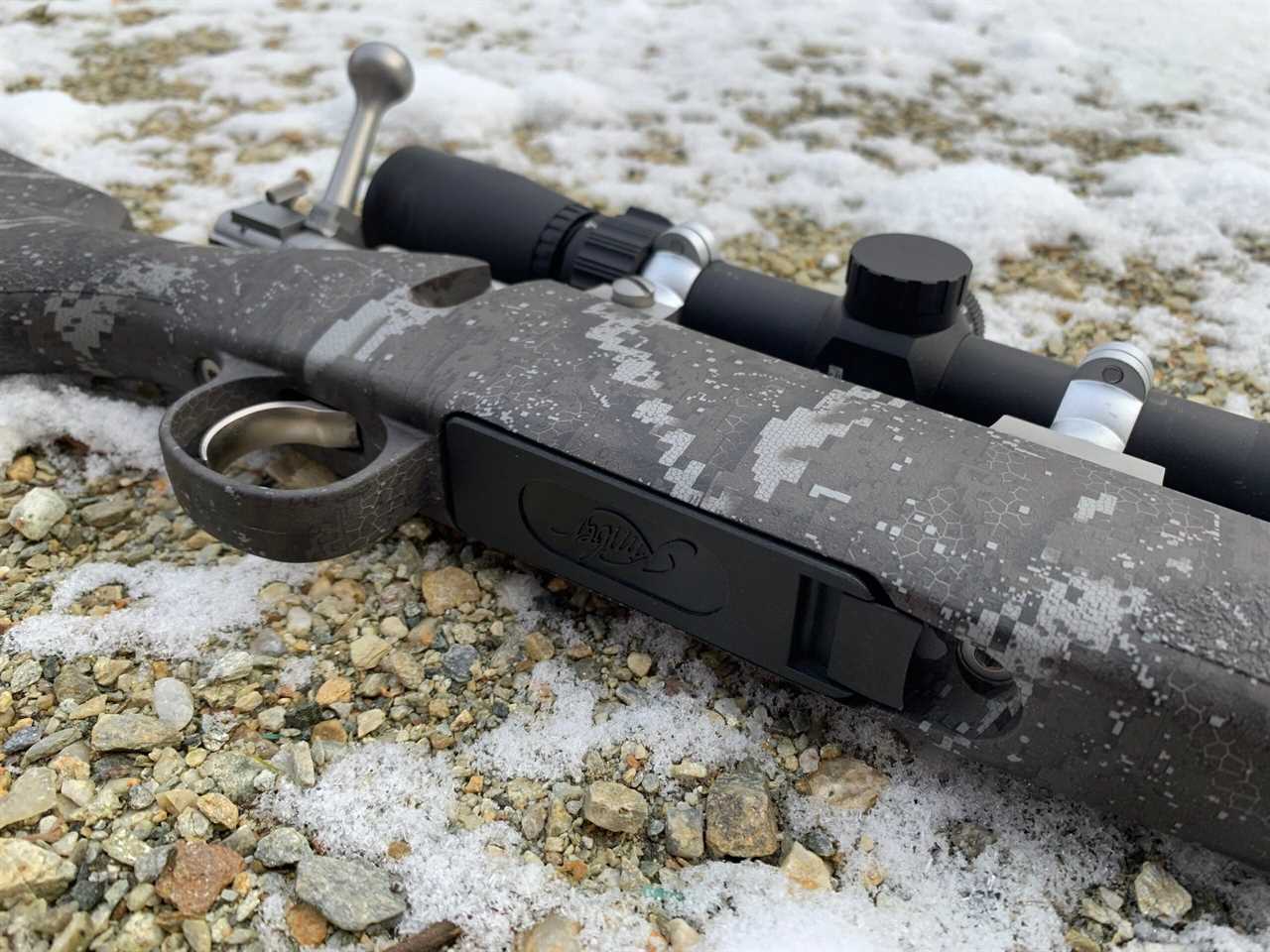
The detachable magazine fits flush with the bottom of the Desolve Black-pattern stock. Tyler Freel
The rifle is fed from a detachable box magazine that sits flush with the bottom of the stock. It’s inserted by placing the tab at the rear of the magazine into the corresponding cutout in the stock, then rocking in from back to front.
I found that with several loads like Federal Premium 165-grain Swift Scirocco II, Hornady Match 168-grain ELDM, and Remington 150-grain Core-Lokt Tipped, the first three shots of a group would regularly range from .75 to 1 inch. After that, the barrel heat consistently opened groups up a bit, but for an ultralight rifle in this price range, the accuracy is good.
Best for the Money: Tikka T3X Lite
Why It Made the Cut
The Tikka T3X Lite is our Great Buy Award winner not only because it’s one of the most affordable in its class, but because it’s an exceptional rifle for the price. It’s more accurate and uses higher-quality parts, and has a better trigger than several pricier rifles in this review.
Key Features
- Cartridge: .308 Win.
- Capacity: 3+1 rounds, detachable box magazine
- Action: Bolt action, two-lug, 70-degree throw
- Stock: Polymer, 1-inch recoil pad, modular grip
- Weight: 6 lb. 9 oz. (measured)
- Trigger: Single-stage, 3 lb. 2 oz. (measured)
- Barrel: 22 in., blued
- Overall Length: 42.5 in.
- Price: $680
- Optic Used: Leupold VX Freedom 4-12 x 40mm CDS
- Average Group Size: 1.96 in.
- Average of Top 10 Groups: 1.33 in.
Pros
- Excellent price
- 70-degree throw, smooth bolt
- Good accuracy
- Great trigger
Cons
Product Description
The Tikka T3X family has a cult-like following, especially here in Alaska. These rifles are affordable, accurate, and dependable. They aren’t ultralight, but aren’t too heavy either. The Finnish rifles have a proven track record and are never a bad option for someone looking for a mid-priced hunting rifle.
The T3X Lite is a sleek and simple rifle. It’s like a budget rifle, only nicer in just about every way. It features a closed-top action and simple two-lug stainless-steel bolt. It has a short bolt throw for a two-lug action, and it’s exceptionally crisp and smooth for its class. The bolt features a metal rear shroud, and the bolt handle is dovetailed into the bolt body.
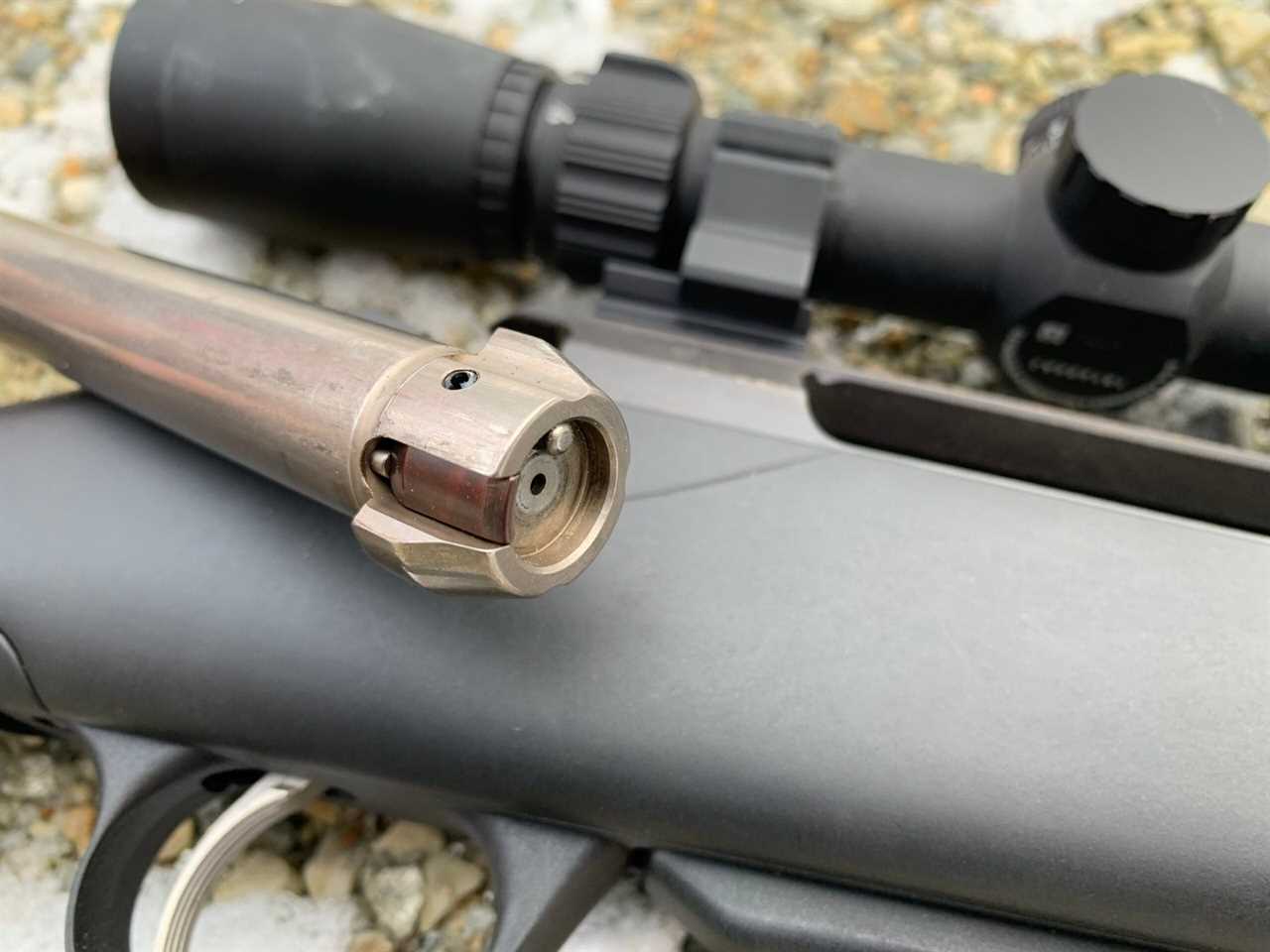
The two-lug bolt of the Tikka T3X Lite has a short 70-degree throw and is smooth to operate. Tyler Freel
The stock is a simple black injection-molded polymer but has excellent texturing on the fore-end and interchangeable grip. It fits the action and barrel nicely. The trigger guard and bottom plate are polymer, and the single-stack polymer magazine extends below the bottom of the stock without impeding single-handed carry.
The rifle is plain but shows good craftsmanship and attention to detail. Even the small textured portion of the bolt release button matches the texture pattern of the stock—a nice touch. Overall, the T3X Lite is a very sleek and clean rifle, with no sloppy machine work or tool marks. It’s very well-balanced for an all-around hunting rifle. The only complaint I could come up with is that the blued sample I have has a finish that is very susceptible to surface rust, so keep it oiled up or pick the stainless model for $190 more!
Shooting the Tikka T3X Lite
Of all the rifles that the internet lauds with unrealistic accuracy expectations, it’s the Tikka. However, it’s not enchanted with the bullet-stacking accuracy of something like the Alterra Arms Mountain Shadow Steel like some folks will insist. The T3X Lite is what it is—an excellent rifle for the price.
The T3X Lite has a great factory trigger that is crisp with virtually no take-up or overtravel. That plus the rifle’s good balance, and the comfortable grip make it comfortable to shoot for a sporter-weight rifle. I tested 11 different factory loads in my T3X Lite, focusing my efforts on loads that it shot better, to see its full accuracy potential.
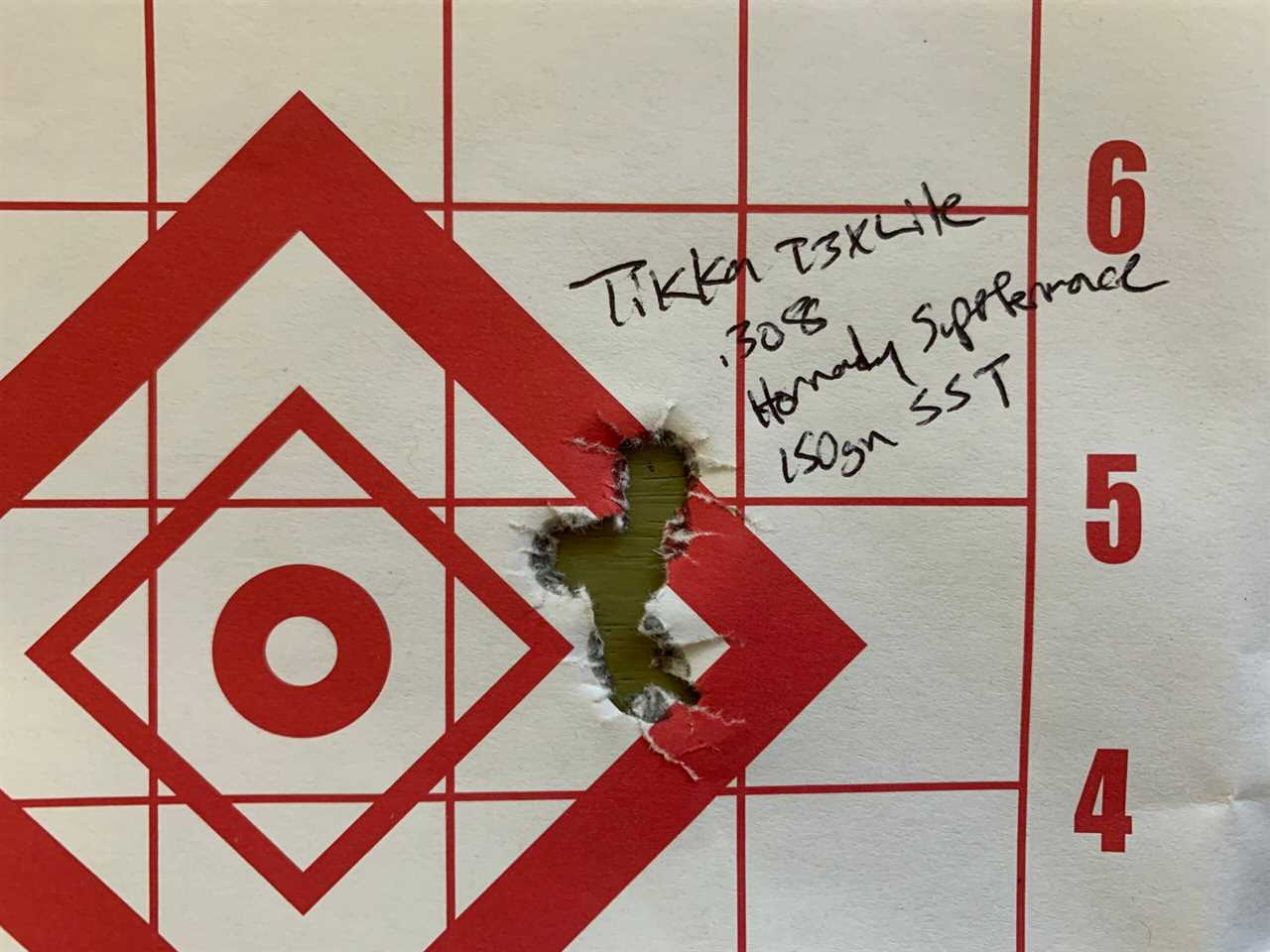
The T3X Lite can print some excellent 5-shot groups like this one, but the more realistic average was 1.33 inches. Tyler Freel
Like some of the other rifles, I noted that with several loads, the Tikka would print the first 3 shots in a tight group, under an inch on average. Also, like other rifles in its class, groups consistently began opening up by rounds four and five.
The T3X Lite is a fast rifle to run, and very comfortable in field positions. The plunger ejector spits out empties robustly, and the bolt closes and locks effortlessly.
Best Long Range: Browning X-Bolt Western Hunter LR
Why It Made the Cut
The Browning X-Bolt Western Hunter LR is far-and-above the best choice in this set for long-range shooting and hunters who might have to make a shot at long distance. The rifle is still light enough to pack around the hills, but the adjustable cheek piece and heavier barrel are well-suited for accurate and consistent shooting at long range. It shot the best groups of the test.
Key Features
- Cartridge: 6.8 Western
- Capacity: 3+1 rounds, detachable rotary magazine
- Action: Bolt action, three-lug, 60-degree throw
- Stock: Composite, In-Flex recoil pad, adjustable comb
- Weight: 8 lb. 2 oz. (measured)
- Trigger: Single-stage, 3 lb. 12 oz. (measured)
- Barrel: 24 in., blued, sporter SR contour, threaded
- Overall Length: 46.25 in.
- Price: $1,000
- Optic Used: Nightforce NX8 2.5-20 x 50mm
- Average Group Size: 1.28 inches
- Average of Top 10 Groups: 0.93 inches
Pros
- Smooth action and crisp trigger
- Adjustable comb on stock
- Medium-heavy barrel is suppressor ready
- Very accurate
Cons
Product Description
The Browning X-Bolt is a highly popular flagship model rifle, and for good reason. They’re generally accurate, dependable, and come in a variety of configurations. Many of their configurations pushes them beyond the category of mid-priced hunting rifles, but the X-Bolt Western Hunter LR can be found at retailers for under $1,200.
The X-Bolt is a three-lug push-feed action that’s fed from a rotary magazine with a rounded bottom, which sits flush with the profile of the stock. It uses an M-16-style extractor and single plunger ejector. It has a two-position safety on the tang that locks the bolt closed when engaged, but the bolt has an override button to allow the shooter to open the bolt or unload while the rifle is on “safe.” The cheek piece is comfortable, and the pistol grip aids with consistent hand placement and trigger pull.
This rifle is a middle ground between more standard sporter-weight and lightweight rifles like the Speed and Mountain Pro, and some of their heavier target models. As the name implies, the Western Hunter LR is designed to be a rifle that’s handy enough to pack around, but capable of shooting game at longer distances.
To hit that middle ground, the standard X-Bolt action is fitted with a medium-heavy 24-inch threaded barrel and sits in a standard-sized stock like you might see on the X-Bolt Speed. However, this stock includes an adjustable cheek piece, and the action comes fitted with a 20-MOA Picatinny rail. The metal is all blued finish, and the camo stock is now being made in Browning’s OVIX pattern, although mine is in ATACS.
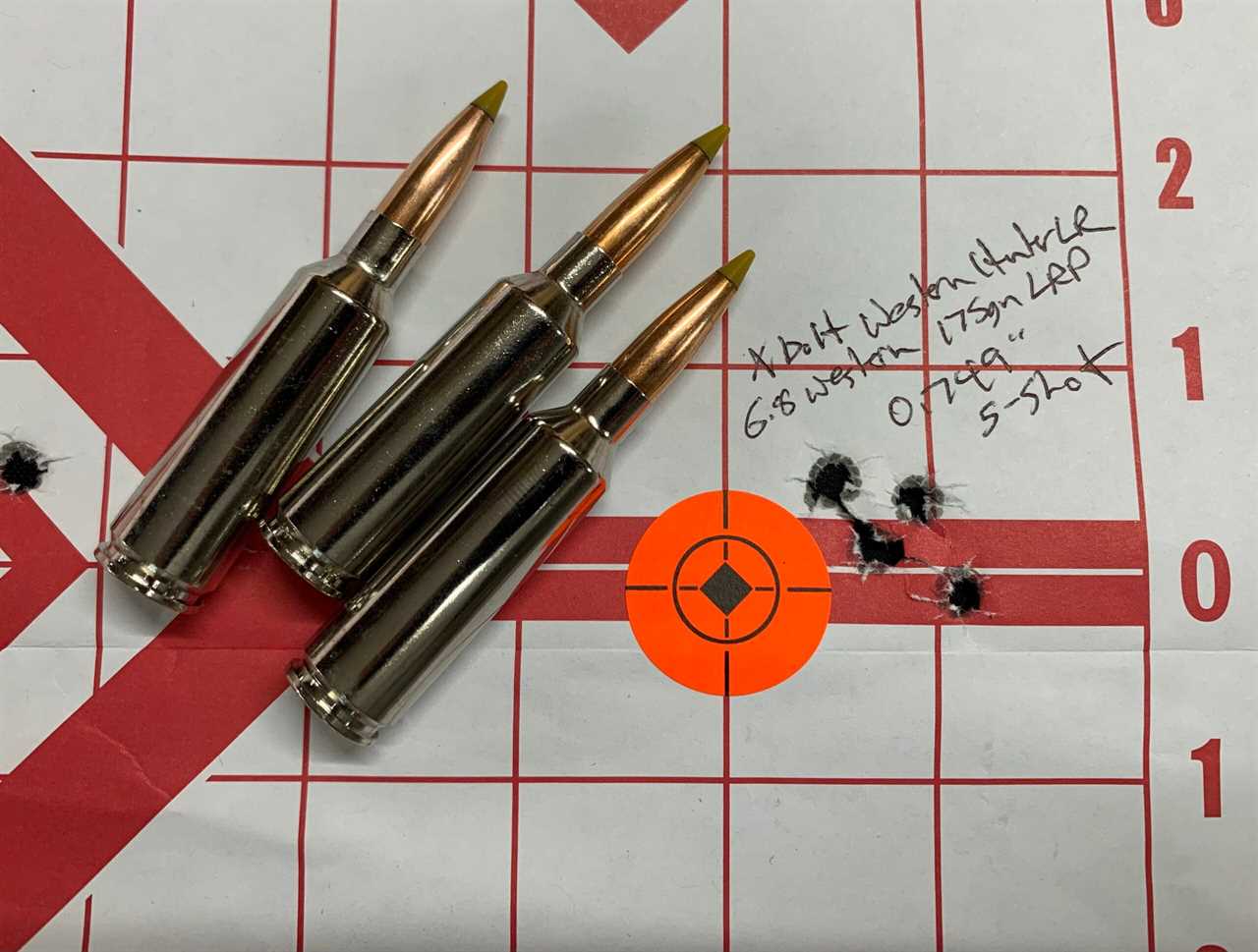
The X-Bolt Western Hunter LR printed consistent groups with Browning’s Long Range Pro Hunter load, shooting 175 grain Sierra Tipped Game King bullets.
Shooting the Browning X-Bolt Western Hunter LR
Within this price bracket, there is some wiggle room for hunting rifle features, and the Western Hunter LR leans toward the slightly heavier, long-range features. Because of that, it was unsurprisingly the most accurate rifle in this test group.
My sample is chambered in the relatively new 6.8 Western cartridge, and I did my test firing with a thread protector rather than a muzzle brake. Ammunition choices are more limited than with the .308 Win. rifles, so I had four loads to work with. The two most accurate loads were Winchester’s Expedition Long Range with 160-grain Nosler Long-Range Accubond, and Browning’s Long Range Pro Hunter with 175-grain Sierra Tipped Game King bullets. The Browning LRP load generally carries more energy across the board than the 6.5 PRC and surpasses the energy of factory .300 Win. Mag. loads like the Barnes 180-grain Vor-Tx TTSX at about 400 yards. It’s got some pep.
The Western Hunter LR shot each load I tried consistently. The average of the top groups came in at under an inch, and the best five-shot group was 0.69 inches. That group was with the Winchester 160-grain ABLR load, but I had only half a box, so the sample size was small. Over half my groups (12 exactly) were with the Browning 175-grain LRP load, and the standard deviation in group size was only .38 inches.
Winchester Model 70 Featherweight
Key Features
- Cartridge: .308 Win.
- Capacity: 5+1 rounds, hinged floorplate
- Action: Bolt action, two-lug, pre-64-style controlled-feed
- Stock: Black Walnut, Pachmayr recoil pad, Featherweight checkering and Shnabel fore-end
- Weight: 7 lb. 0 oz. (measured)
- Trigger: Single-stage, 4 lb. 2 oz. (measured)
- Barrel: 22 in., blued, Featherweight contour, recessed target crown
- Overall Length: 42.25 in.
- Price: $950
- Optic Used: Leupold VX3HD 4.5-14 x 40mm CDS
- Average Group Size: 2.26 in.
- Average of Top 10 Groups: 1.79 in.
Pros
- Classic Featherweight feel
- Good metal-to-wood fit
- Pre-64-style controlled-feed action
- Classic wood-stocked hunting rifle
Cons
Product Description
The Winchester Model 70 Featherweight is one of the longest-running mid-priced hunting rifles that’s still in production. The featherweight was first released in 1952, and the signature “Featherweight” stock was introduced in 1982. The rifle has seen some changes, but the current production model has a pre-64-style controlled-feed action that Model 70 fans love.
The Featherweight was a lightweight rifle for its time and introduced in the brand new .308 W.C.F. cartridge of 1952 (what we now know as the .308 Win.). That’s what I tested the current production model in, and with the post-1982 Schnabel fore-end and signature checkering, it’s an authentic Featherweight.
The controlled-feed action features a two-lug bolt and Mauser-style claw extractor, as well as a coned breech for feeding reliability. It also uses a blade ejector rather than a spring-loaded plunger. The blade ejector ejects cases with a force proportional to how hard the bolt is pulled to the rear. Need to reload in a hurry? Grip it and rip it. On the bench though, you can slowly pull the bolt to the rear and hand-pluck your spent case from the bolt face. Because the claw extractor grabs and controls the cartridge as soon as it’s stripped from the magazine, you don’t have to close the bolt to withdraw the cartridge from the chamber like you do with most push-feed rifles.
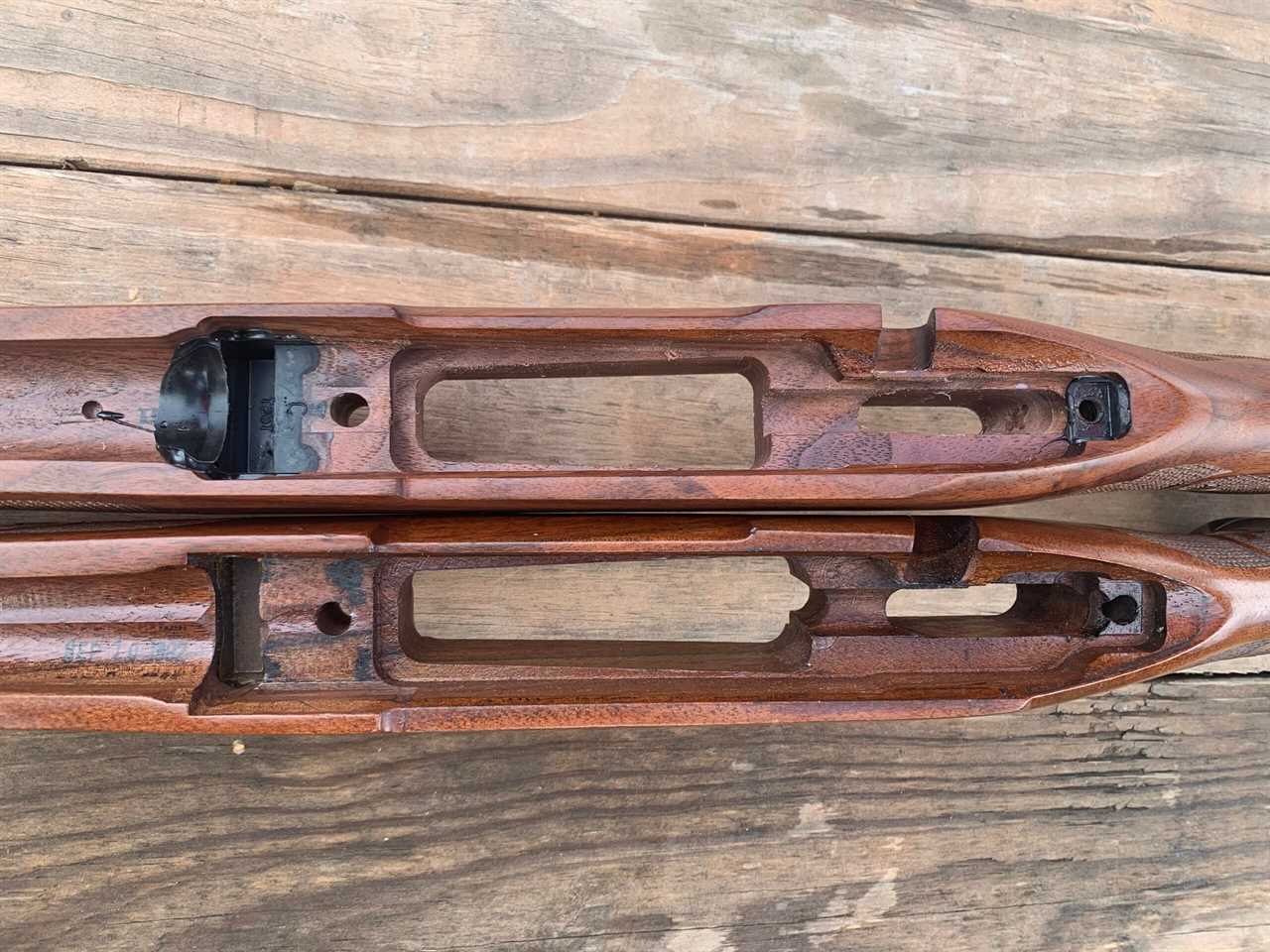
The current production Featherweight has a controlled-feed action and bedding at the tang and recoil lug (top) where older models (bottom) had none. Tyler Freel
The wood stock is warm and comfortable and features good wood-to-metal fit with only a couple uneven spots on my sample. Unlike older models, the stock features bedding around the recoil lug and at the tang to help reinforce the wood and provide a more stable connection. My only complaint with the stock is that it’s slightly thicker and blockier than older model Featherweights, particularly in the grip and around the magazine floorplate.
The metal on the rifle features a nice satin blued finish, and the muzzle has a recessed target crown that’s well-protected. An older Model 70 Featherweight I have possesses only a slightly contoured crown, and the muzzle shows some wear from riding around on the floorboards of a pickup.
Shooting the Model 70 Featherweight
The Featherweight in .308 Win. is a well-balanced hunting rifle that is more of an average-weight rifle today. The geometry of the stock and the Pachmayr recoil pad make it comfortable to shoot, and Winchester’s MOA trigger system is crisp and not too heavy.
For accuracy, the Featherweight came in about how I expected—acceptable, but not exceptional. Across a wide variety of factory ammo, there weren’t any loads that shot lights-out, but for a production wood-stocked rifle with a lightweight barrel, it’s not bad. Most deer certainly wouldn’t notice. As with several rifles in this category, there’s a notable difference in the accuracy the rifle can hold for three shots versus five.
For a walking hunting rifle, or for anyone who still loves the classic wood-stocked feel, it’s a great choice. The Featherweight is very comfortable and reliable in handling drills and rapid cycling. It’s also a plus that the magazine holds a whole 5-rounds—something that isn’t as common anymore.
Howa 1500 Kuiu Verde
Key Features
- Cartridge: .308 Win.
- Capacity: 5+1 rounds, hinged floorplate
- Action: Bolt action, two-lug, push-feed, tactical gray Cerakote
- Stock: Hogue synthetic, pillar-bedded
- Weight: 7 lb. 9 oz. (measured)
- Trigger: Two-stage, 2 lb. 13 oz. (measured)
- Barrel: 22 in., tactical gray Cerakote, threaded ½-inch x 28
- Overall Length: 42.5 in.
- Price: $736
- Optic Used: Leupold VX6HD 2-12x42mm CDS ZL
- Average Group Size: 2.20 in.
- Average of Top 10 Groups: 1.62 in.
Pros
- Three-position bolt-locking safety
- Durable, comfortable stock
- Excellent trigger
- Threaded muzzle
Cons
- Ejecting brass nicks receiver finish
Product Description
The Howa 1500 is another long-running hunting rifle that has models in the $600-$1,200 price range. The Model 1500 has been in production since 1979, and it’s been a staple, affordable rifle for many hunters. I killed my first coyote with a 1500 in .223 that my dad bought when I was a kid, and one of the most accurate rifles I’ve ever owned was a heavy-barreled Model 1500 with a laminated thumbhole stock in .308 Win.
Like many rifles, the 1500 comes in a variety of configurations and price ranges—including carbon-fiber barrels and high-end stocks. One of the base models that fits this category perfectly is the Kuiu Verde in .308 Win. The rifle features a tactical gray Cerakote finish, sporter-weight barrel, and a Hogue Kuiu-camo stock with a wide fore-end, meaty grip, and soft recoil pad.
The Howa Model 1500 action is a simple two-lug push-feed action—much like the Remington 700. Unlike the 700, it features an M-16-style extractor, but does have a single plunger ejector on the bolt face. The recoil lug is machined into the action, and Howa’s trigger group is attached to the action with a single Allen screw.
Sitting in the stock, the barrel channel is even, and the barrel is free floated completely back to the receiver. The stock is beefy, but comfortable to shoot. It has a wide fore-end, and a thick, nearly vertical grip which makes a perpendicular pull on the trigger easy.
The barrel has a slightly recessed crown, and the muzzle is threaded, although it’s notable that the thread pitch is ½-inch x 28 (a threading that is most common with .22-caliber chamberings) rather than the more common 5/8-inch x 24. The muzzle is ready to be fitted with either a brake or suppressor. Because the barrel is a relatively light sporter weight, expect major point-of-impact shifts when adding a can.
Shooting the Howa Model 1500 Kuiu Verde
The Model 1500 Kuiu Verde is a very easy hunting rifle to shoot. Its weight and stock ergonomics provide a stable platform, and the light two-stage trigger breaks very crisply. Often, two-stage triggers feel lighter than they are because a portion of the weight is taken up before hitting the rigid stop at the second stage. A little more weight added breaks the trigger over. This one pulls at less than three pounds on my Lyman trigger pull gauge, and it feels exceptionally light for a factory production hunting rifle.
I felt confident in my shooting with this hunting rifle, but accuracy wasn’t fantastic. I tried 10 different factory loads, and there weren’t any standouts. A couple of loads the rifle really didn’t like dinged its overall average group size, but most ammunition averaged between 1.5 and 1.75 inches. The two most accurate loads were Remington’s 150-grain Core-Lokt Tipped, and Federal Premium 180-grain Trophy Bonded Tip.
The rifle fired and cycled reliably, but I did notice that the ejector tended to flip the case neck into the rear portion of the receiver, nicking the Cerakote finish. This is something I’ve noticed on another Model 1500 as well.
Savage 110 Storm
Key Features
- Cartridge: .308 Win.
- Capacity: 4+1 rounds, detachable box
- Action: Bolt action, two-lug, push-feed, Stainless-steel
- Stock: Synthetic, adjustable Accustock with bedding block
- Weight: 7 lb. 9 oz. (measured)
- Trigger: Single-stage, Savage Accutrigger, 3 lb. 4 oz. (measured)
- Barrel: 22 in., Stainless-steel
- Overall Length: 42.25 in.
- Price: $750
- Optic Used: Maven RS.2 2-10 x 38mm
- Average Group Size: 2.18 in.
- Average of Top 10 Groups: 1.46 in.
Pros
- Adjustable stock with quality texturing
- Good, user-adjustable trigger
- Stainless-steel parts offer good corrosion resistance
- Steel Magazine is durable
Cons
- Excessive tool marks in the bore on my sample
- Magazine bottom plate shows spot rusting from ambient humidity
Product Description
The Savage Model 110 is a stalwart of the mid-priced hunting rifle category and has been since its introduction in 1963. In-fact, it was one of the major competitors that pushed Winchester to adopt a push-feed design for the Model 70 in 1964, according to Jack O’Connor’s writings at the time.
The Model 110 is a simple push-feed, bolt-action rifle that features a second set of lugs behind the forward set. This could still be considered a two-lug bolt because only the forward lugs rotate and lock into the receiver, but the rear ones spin freely around the bolt body and remain in the raceways while the bolt is locked into battery. The bolt handle is cast, and the bolt features a small plunger ejector and an extractor that’s fitted into the right-hand lug (something the push-feed Winchester Model 70 used as well).
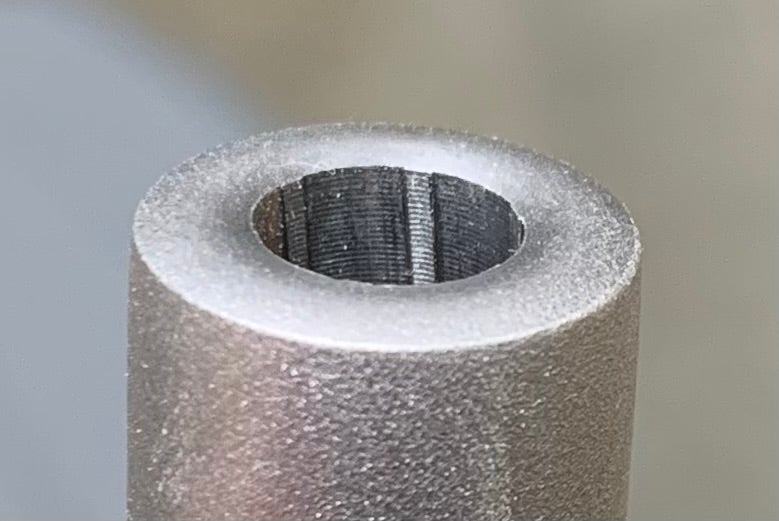
Despite some serious chatter in the bore of my sample M110 Storm, the rifle shot 150 grain Remington Core-Lokt Tipped loads surprisingly well. Tyler Freel
The Savage Model 110 is a hunting rifle that was designed to be affordable and accurate, and it carries a reputation for both. The Model 110 Storm that I tested features a stainless-steel receiver and barrel, and a detachable 4-round magazine. I like the design of the magazine because it’s durable, but I did notice that the stainless-finish bottom plate has picked up some surface spot rusting simply from the ambient humidity. The loaded magazine takes firm pressure to insert into the rifle, but it springs free with authority when the magazine release is pressed.
The rifle features a 3-position tang safety that locks the bolt in its most rearward position. It also uses Savage’s Accutrigger—a user-adjustable trigger with a center safety tab. It’s a well-liked and crisp-breaking trigger that certainly aids with the shootability of the rifle.
Savage has made great improvements in their synthetic stocks in the last few years. They were often cheap-feeling with flimsy fore-ends, but the one on the Storm is well-executed, and has an internal bedding block. The floated barrel fits evenly in the barrel channel, the stock’s lines are clean, and it has an excellent rubberized grip texture on the fore-end and grip. The stock adjusts for comb height and length of pull.
Shooting the Savage Model 110 Storm
My only significant complaint with my sample M110 Storm is that the bore on my sample has excessive tooling chatter marks that run perpendicular to the rifling. I noticed it after an initial firing and cleaning of the rifle. The marks are noticeable to the naked eye, and I could feel them by running a dental pick lightly along the inside of the bore. It’s not the norm on rifles that I’ve seen from Savage, but it’s something that I will be careful to look for in the future.
Regardless, I wanted to see what this rifle would do, and it shot damn well (all things considered). I fired 24 groups total, with seven different types of ammunition. Most of the ammunition didn’t shoot well, averaging 2.58 inches. There were a few good groups, but accuracy was erratic. One load that the rifle did like was the Remington 150-grain Core-Lokt Tipped. Ten groups with that ammunition yielded an average of 1.61 inches, and many of the larger groups were spoiled by a single erratic impact.
The bore certainly didn’t do this rifle any favors for accuracy, but the average of 1.46 inches for the top 10 of 24 groups isn’t bad for a hunting rifle of this class. Frankly, it’s remarkable that it shot as well as it did. The rifle functioned reliably, although the M110 has a stiff bolt lift, and the slightly rough stainless finish in the raceways gave my sample a gritty feeling when operating the bolt.
Weatherby Vanguard First Lite
Key Features
- Cartridge: 6.5-300 Weatherby Magnum
- Capacity: 3+1 rounds, hinged floorplate
- Action: Bolt action, two-lug, push-feed, Cerakote finish
- Stock: Synthetic, First Lite Cipher camo finish
- Weight: 7 lb. 10 oz. (measured)
- Trigger: Two-stage, 3 lb. 3 oz. (measured)
- Barrel: 26 in., fluted, threaded with muzzle brake and thread protector, Cerakote Finish
- Overall Length: 48.5 inches (with muzzle brake)
- Price: $1,000
- Optic Used: Leupold Mark 5HD 3.6-18 x 44
- Average Group Size: 1.96 in.
- Average of Top 10 Groups: 1.64 in.
Pros
- Great trigger
- Weatherby in-house Cerakote finish on metal parts
- Fluted Barrel
- Comfortable raised Monte Carlo comb on stock
Cons
- 6.5-300 chambering likely isn’t the most accurate choice for this rifle
Product Description
If you notice the resemblance between the Weatherby Vanguard series and the Howa 1500, it’s because they are very similar. Howa makes the barreled actions for the Vanguard line, though Weatherby finishes them in Sheridan, Wyo. by adding the stock, trigger, barrel fluting, finishes, etc. The Vanguard series was introduced in 1970 to offer a lower-priced option than the premium Mark V line, and firmly fits the bill for a quality mid-priced hunting rifle.
Like the Model 1500, the Vanguard is a two-lug push-feed action—nearly identical except for a few differences. One is that the Vanguard’s bolt features three small gas vent holes that are visible on the ejecting side when the bolt is closed. The Model 1500 only has the forward hole. Additionally, the Model 1500 has three larger vent holes in the bolt body that point down towards the magazine when the bolt is closed. The Vanguard only has one.
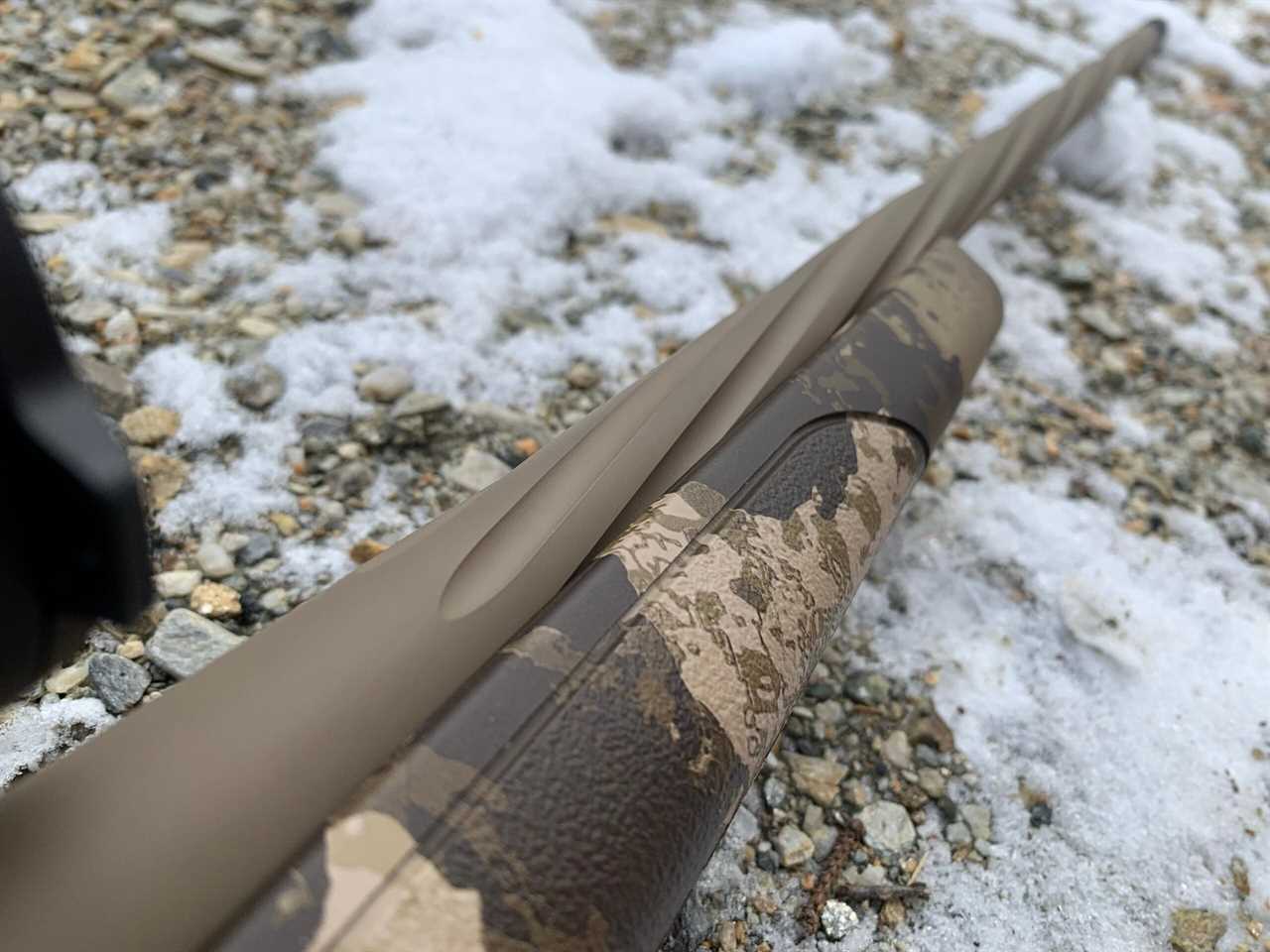
The Vanguard First Lite has a nicely fluted and Cerakoted barrel. Tyler Freel
The Vanguard First Lite features a relatively slender, high-quality synthetic stock. The fore-end is slightly widened at the bottom with a slimming taper closer to the barrel. The Monte Carlo comb provides a comfortable and firm cheek weld, and the subtle texturing on the grip and fore-end make the rifle easy to handle and hold. The stock is finished with First Lite Cipher camouflage pattern.
One notable feature is the rifle’s Cerakote finish, which is even, good-looking, and done in-house at their Sheridan, Wyoming factory. The rifle includes both a slim radial muzzle brake and thread protector—both machined to fit the barrel profile perfectly. The fit is precise, and it’s hard to see the seam when the muzzle brake or thread protector are tightened.
Shooting the Weatherby Vanguard First Lite
In an apples-to-apples comparison, it’s probably not fair to shoot a fluted, sporter-weight 6.5-300 Wby Mag. against similar-class rifles in .308 Win. The 6.5-300 is an incredibly fast, flat-shooting cartridge, but it will heat up a barrel quickly and is generally much less forgiving than cartridges like the .308 Win. and 6.5 Creedmoor. However, the only sample Weatherby had available was chambered for 6.5-300, and I was excited to see how it would fare.
I had two loads to work with, Weatherby Select 140-grain Hornady Interlock, and Weatherby Select Plus 127-grain Barnes LRX. I can tell you from experience that the latter of those two loads will shoot clean through a bull moose at 500 yards. Like the other rifles, I fired five-shot groups without breaking position, letting the barrel cool completely between groups.
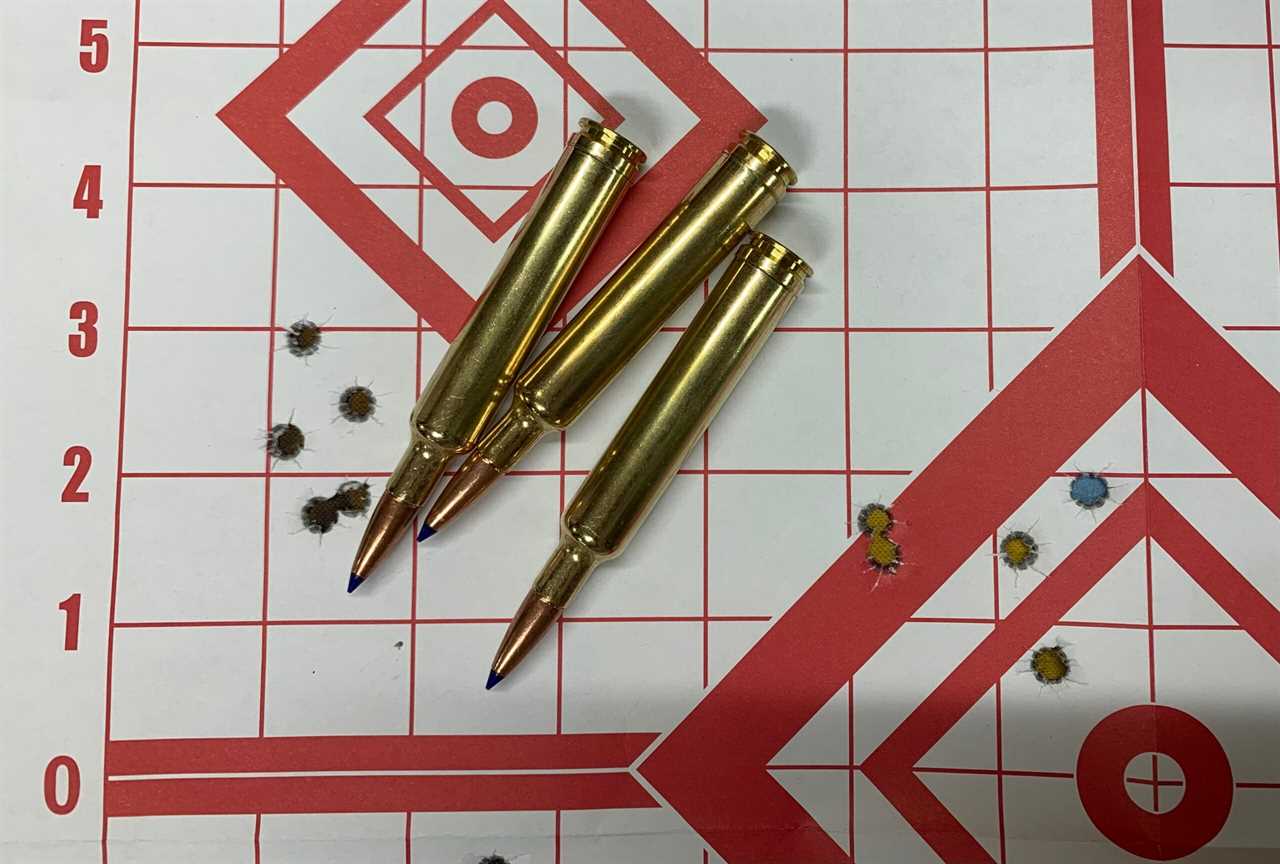
Average representative groups from the 127 grain LRX in 6.5-300 Wby. Mag. Groups would begin to spread after the first three shots. Tyler Freel
The Vanguard shot a little better than I expected, and it’s top 10 groups averaged just over 1.5 inches. The rifle was clearly affected by the heat and followed a consistent pattern. Approximately seven out of ten groups would start with the first three shots printing at or under an inch, then on round four or five, that barrel would go running for the hills. Often, the overall group size was still OK, but it printed more than a handful of 2.5 to 3-inch groups.
This rifle in 6.5-300 Wby. Mag. would make an excellent “maximum point blank” rifle for a hunter who might be presented with longer shots but doesn’t want to mess with holdover reticles or adjustable turrets. However, it’s not consistently accurate enough to be a dedicated long-range rig in my opinion.
From the 2022 Gun Test
A benefit of Outdoor Life’s annual gun test is an accumulation of quality data, and the Best Rifles of 2022 test featured several good mid-priced hunting rifles. The only significant differences between testing the rifles already mentioned and the ones to follow are the chamberings and volume of data. In April, we had a team of five shooters shooting groups with each rifle, giving us a large amount of data. When interpreting the average size of a rifle’s top ten groups, keep in mind that a larger overall data set will often yield a smaller “top 10” average group size.
The three rifles were chambered in either 6.5 Creedmoor or 6mm Creedmoor and shot their best groups with match ammunition. I handled and fired groups for accuracy for each of these rifles back in April, and they certainly belong on this list.
Franchi Momentum Elite
Key Features
- Caliber: 6.5 Creedmoor
- Capacity: 3-round detachable box magazine
- Weight: 7 lb. (measured)
- Action: Three-lug bolt
- Stock: Synthetic
- Trigger: 3 lb., adjustable (measured)
- Barrel: 24 in., threaded with muzzle brake
- Overall Length: 46.25 in.
- Price: $800
- Average of Top 10 Groups: .887 in.
Pros
- Excellent accuracy for the price
- Crisp 3-pound trigger
- Short bolt throw
- Optics rail included
Cons
- Magazine only holds 3 rounds
- Our sample had a rough chamber, scratching cases on extraction
Product Description
The Franchi Momentum Elite is a sleek mid-priced hunting rifle that posted excellent accuracy scores at our 2022 gun test. It features a 3-lug push-feed bolt with a short, crisp throw that makes the rifle quick and easy to cycle. Chambered in 6.5 Creedmoor, it favored Federal Premium’s 140-grain Sierra Match King and Nosler’s 140-grain RDF target loads.
The Momentum Elite handled well, and the only real complaint I had with it was that the magazine only held three rounds, and the magazine release is inside the trigger guard.
The Momentum Elite’s stock is slender with good ergonomics, and it features and integral recessed sling swivel stud that’s molded into the stock. It also has a rubber stopper inside a tapped hole for a standard sling swivel stud in case you want to attach a bipod.
The rifle has a nice finish and includes a radial muzzle brake and one-piece optics rail. You can also get the Momentum Elite in 6.5 PRC, .308 Win., .300 Win. Mag., and .350 Legend.
CZUSA 600 Alpha
Key Features
- Caliber: 6mm Creedmoor
- Capacity: 5-round detachable box magazine
- Action: Three-lug bolt
- Stock: Synthetic
- Weight : 7 lb. 10 oz. (measured)
- Trigger: 1 lb. 11 oz., adjustable (measured)
- Barrel: 22 in., threaded 5/8-24
- Overall Length: 42.2 in.
- Price: $710
- Average of Top 10 Groups: .814 in.
Pros
- Very accurate
- Stock has good texture and ergonomics
- Simple adjustable trigger
- Threaded muzzle
Cons
- Stock fore-end is a little bit flexible
Product Description
New for 2022, the CZ 600 series is a complete divergence from their previous actions, and the 600 Alpha is the base model for the 600 series. It’s a three-lug, push-feed action that’s fed from a detachable box magazine. Our sample was chambered in 6mm Creedmoor and featured a medium/heavy contoured barrel, and the stock features sharp lines and a grippy, rubberized texture.
The CZ 600 Alpha features an exceptionally idiot-proof adjustable trigger and is very comfortable to shoot. It also has an over-sized bolt knob and threaded muzzle. The rifle has elements of both target and hunting rifles and could fulfill several roles for a hunter who’s looking for bang for their buck. It’s not light, but it’s not exceptionally heavy or long barreled either.
The safety mechanism on the CZ 600 is interesting, as it’s a thru-tang safety that you press down into the tang to disengage, and up from the bottom to engage. The safety locks the bolt, but there is a bolt release button that can be pressed to open the bolt while the rifle is on safe.
The 600 Alpha we tested in April was very accurate and favored Nosler’s 105-grain RDF and Hornady’s 108-grain ELDM target loads.
CVA Cascade SB
Key Features
- Caliber: 6.5 Creedmoor
- Capacity: 4-round detachable box magazine
- Action: Two-lug bolt
- Stock: Synthetic
- Weight : 6 lb. 15 oz. (measured)
- Trigger: 2 lb. 7 oz. (measured)
- Barrel: 18 in., threaded 5/8-24
- Length: 38.5 in.
- Price: $687
- Average of Top 10 Groups: 1.07 in.
Pros
- Handy 18-in. barrel
- Threaded Muzzle
- Oversized bolt knob
- Magazine can be top loaded
Cons
- Plastic magazine isn’t the most durable
Product Description
The CVA Cascade SB (the SB stands for short barrel) is a handy and affordable rifle that’s designed for hunters who operate out of tight spaces and/or run suppressors on their rigs. The rifle is a two-lug push-feed action that feeds from a plastic detachable magazine. I liked that the magazine can be loaded from the top while it’s in the rifle, but its plastic construction is a little vulnerable when it’s not securely snapped into the gun.
The stock has a tacky, grippy texture, and it’s comfortable to handle and shoot. The Cascade SB has double sling swivel studs on the fore-end for mounting a bipod, and a single stud at the rear of the stock.
The short 18-in. 6.5 Creedmoor barrel was accurate, and this Cascade SB is a perfect affordable rifle to fill a number of utilitarian roles. It’s top ten groups averaged just over an inch for our test team, which was middle-of-the-pack of the rifles we tested at the 2022 gun test—most of which were chambered in 6.5 Creed.
Our test team didn’t like how difficult the CVA brand sticker was to remove from the stock, but for the rifle itself, we think it’s a good buy.
Final Thoughts on Mid-Priced Hunting Rifles
The biggest takeaway from accuracy testing mid-priced hunting rifles is that they are generally a step above the budget rifles in accuracy. They will shoot a wider variety of loads with better consistency, but you still might have to spend some time on the bench to find what they really like. Several of the mid-priced rifles have MOA accuracy guarantees for three-shot groups, and I found them all to satisfy their claims.
Most rifles in this price block do fall short of the accuracy of premium rifles when it comes to five-shot groups over time, but this probably won’t bother the average hunter. Many people will claim that their mid-priced rifles will shoot just as accurately as any rifle in the $2,000 to $4,000 range, but that’s usually not true. For example, the worst five five-shot groups that I recorded while testing the Fierce CT Rival were with a couple of loads the rifle didn’t like. They averaged 1.66 MOA. The best five groups averaged 0.52 MOA. The overall average five-shot group for all the mid-priced hunting rifles I tested was 1.95 MOA, and the average of all the rifles’ best 10 groups was 1.42 MOA.
The post The Best Mid-Priced Hunting Rifles Put to the Test appeared first on Outdoor Life.
By: Tyler Freel
Title: The Best Mid-Priced Hunting Rifles Put to the Test
Sourced From: www.outdoorlife.com/guns/best-mid-priced-hunting-rifles/
Published Date: Fri, 21 Oct 2022 20:00:00 +0000
----------------------------------------------
Did you miss our previous article...
https://manstuffnews.com/weekend-warriors/slingshot-kite-takes-on-tarifa-spain
 Backyard GrillingWeekend WarriorsAdvice from DadBeard GroomingTV Shows for Guys4x4 Off-Road CarsMens FashionSports NewsAncient Archeology World NewsPrivacy PolicyTerms And Conditions
Backyard GrillingWeekend WarriorsAdvice from DadBeard GroomingTV Shows for Guys4x4 Off-Road CarsMens FashionSports NewsAncient Archeology World NewsPrivacy PolicyTerms And Conditions
